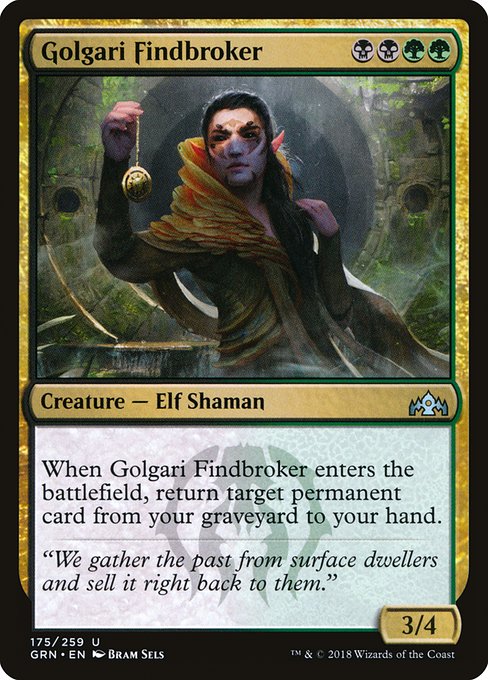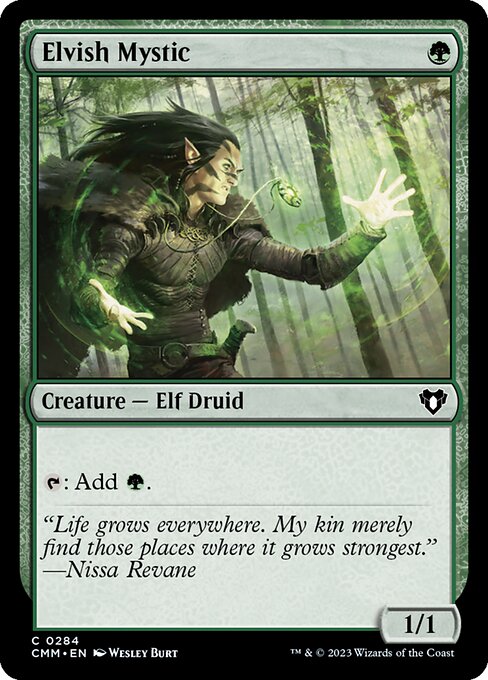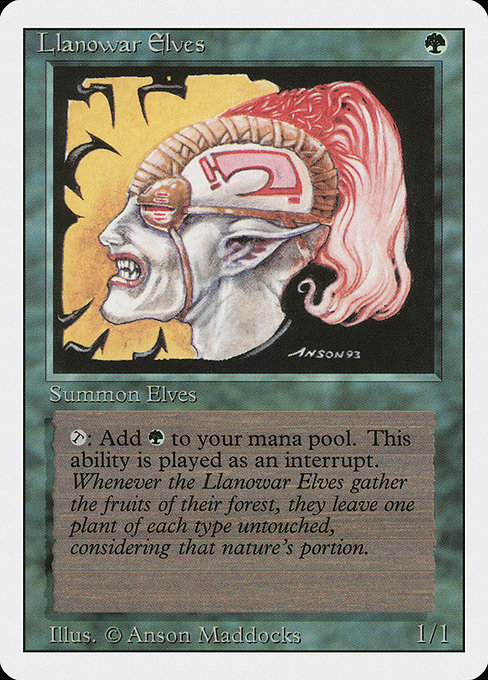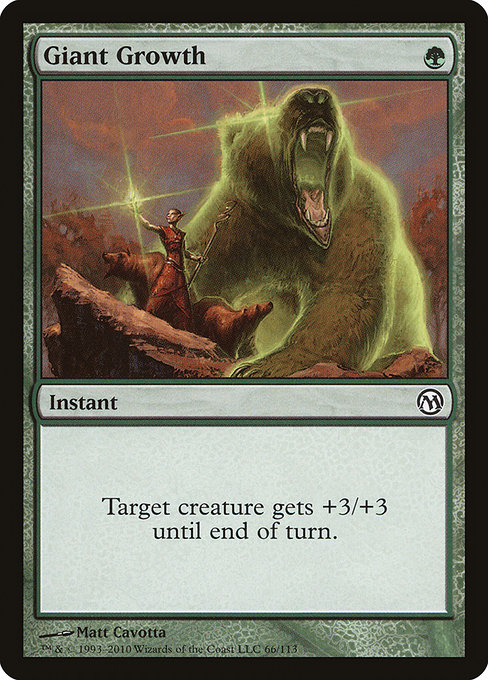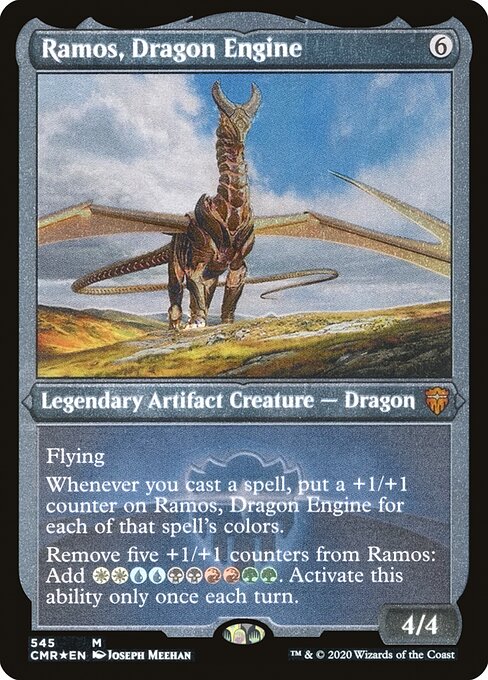
Ramos, Dragon Engine

Guide Sections
Strategy Guide
Last updated 2025-07-06Ramos, Dragon Engine excels at leveraging multi-colored spells to become a massive threat quickly, synergizing well with strategies featuring Niv-Mizzet, Parun or The Locust God. However, its high mana cost and reliance on multicolor spells can make it vulnerable in slower matchups or those lacking sufficient ramp. Its mana generation ability offers powerful late-game value, but only after significant investment.
Ramos, Dragon Engine is a Legendary Artifact Creature with flying, a mana cost of {6}, and starting power and toughness of 4/4. Its primary ability triggers whenever you cast a spell. For each color of mana in that spell's cost, a +1/+1 counter is placed on Ramos. This means a mono-colored spell adds one counter, a dual-colored spell adds two, and so on, up to a maximum of five counters from a five-colored spell. Note that this ability considers the mana cost of the spell, not the mana actually spent to cast it. For example, casting Force of Will would only add one counter (blue), despite the potential for additional mana costs. The interaction with cards like Gemstone Caverns and Prismatic Vista will depend on the mana symbols in the spell's casting cost, as written on the card itself.
The second ability allows the removal of five +1/+1 counters from Ramos to add {W}{W}{U}{U}{B}{B}{R}{R}{G}{G} to your mana pool. This can be used only once per turn. Therefore, strategically accumulating counters is crucial to maximize this ability. This mana generation is powerful, capable of fueling expensive spells or multiple smaller spells. Importantly, this ability is activated, and must be done after the counters have been placed on the creature. There is no immediate benefit of gaining the mana before removing the counters. Furthermore, if Ramos is removed from the battlefield after the counters have been added, but before activation of the mana-generating ability, the mana is not gained.
Ramos, Dragon Engine is a powerful engine for multicolor strategies focused on generating significant mana advantage and board presence. Its strategic value hinges on its ability to synergize with decks that cast many spells, ideally spells with multiple colors. This allows Ramos to quickly amass +1/+1 counters, growing into a formidable threat while simultaneously providing a significant mana source later in the game. The ability to add ten mana of five different colors in a single activation is exceptionally powerful, fueling large, expensive spells like Expropriate or enabling multiple powerful spells in a single turn.
Decks that benefit most from Ramos include five-color strategies and those that emphasize spellslinger-like mechanics. These may include Niv-Mizzet, Parun-style strategies that benefit from casting many instants and sorceries. The sheer volume of spells cast allows Ramos to grow rapidly, often becoming too large for removal to handle efficiently before its mana generation ability comes online. Furthermore, Ramos's ability to generate mana of all five colors makes it an excellent addition to ramp strategies aiming to deploy game-ending threats earlier than usual. Decks built around planeswalkers, which are often multicolored, also benefit from Ramos's ability to grow quickly. For example, Elspeth, Sun's Champion creates tokens that will help accelerate Ramos's growth.
The roles Ramos fills are primarily those of a powerful threat and a mana engine. It operates as a win condition in its own right due to its ability to quickly become an overwhelming attacker, protected by flying. Simultaneously, it functions as a crucial engine, providing the mana necessary to cast expensive spells or multiple spells in a single turn. The high mana cost of 6 is a significant drawback, however this is usually offset by its fast growth and value provided by mana generation. Consequently, Ramos is a powerful card that rewards strategic spellcasting and offers powerful late-game potential.
Ramos, Dragon Engine's power lies in its ability to rapidly grow larger and provide significant mana ramp. The key to maximizing its effectiveness lies in casting many multicolored spells. A successful Ramos deck will focus on spells with a high number of colors to rapidly increase its power and then leverage the mana generated by its activated ability.
Focusing on multi-colored spells is paramount. Cards like Five-Color Control, while expensive, are highly synergistic. Scapeshift offers a powerful way to quickly deploy lands and facilitate casting high-cost multicolored spells. Consider including several ramp spells to accelerate the process of getting Ramos onto the battlefield sooner, such as Rampant Growth and Cultivate. Once Ramos is established, powerful multicolored planeswalkers such as Nissa, Who Shakes the World and Teferi, Who Slows the Sunset become extremely potent. Their abilities trigger Ramos’s counter-placing ability repeatedly, quickly making it a formidable threat.
The activated ability to create ten mana of five colors is immensely powerful, allowing for game-ending plays. This makes cards with high mana costs, like Ugin, the Spirit Dragon and Karn Liberated, exceptionally attractive inclusions. These powerful threats can be summoned quickly thanks to the mana surge from Ramos' activated ability. Finally, consider including protection for Ramos, such as Swiftfoot Boots or Lightning Greaves, to protect your investment from removal spells. The goal is to leverage the synergies between multiple colored spells, ramp, and powerful finishers to win quickly and aggressively.
Ramos, Dragon Engine's viability is heavily format-dependent, shining brightest in formats that allow for consistent and explosive spell-slinging. In Standard, its high mana cost presents a significant hurdle. While the +1/+1 counter generation is powerful, reaching six mana consistently enough to cast Ramos and then follow up with impactful spells to leverage his ability is difficult. The mana ramp available in Standard may not be sufficient to reliably get him onto the battlefield quickly enough to impact the game before an opponent secures an advantage. Furthermore, the lack of consistent payoff for the mana generated from removing counters limits its appeal in the face of faster strategies.
Historic presents a slightly more favorable environment. With access to a broader card pool, potentially including more efficient mana-acceleration strategies like Growth Spiral or Arcane Signet, Ramos becomes more achievable. However, Historic still favors quicker strategies, and Ramos's hefty mana cost makes him vulnerable to early aggression. He could find success in more controlling midrange strategies, but requires significant deckbuilding support to mitigate his inherent slowness.
Commander, on the other hand, is where Ramos truly shines. The higher player count and greater mana availability make the six-mana cost significantly less prohibitive. Ramos synergizes incredibly well with strategies focused on casting many spells of various colors. Decks centered around Arcane Signet, Sol Ring, and other ramp spells can readily get Ramos onto the battlefield early. Once there, he quickly becomes a massive threat, accumulating +1/+1 counters from the numerous spells played in Commander games. The ability to generate ten mana from removing his counters provides explosive plays, acting as a powerful mana sink for high-cost spells or enabling powerful combos. His strength lies in his ability to leverage the inherent chaotic nature of Commander games.
Ramos, Dragon Engine shines in situations where you're casting multiple multicolored spells in a single turn. Imagine a board state where you've already played several lands and have a hand containing Crackle with Power, Fblthp, the Lost and The Wandering Emperor. Casting Crackle with Power first adds three +1/+1 counters (red, blue, and green) to Ramos. Then, casting Fblthp, the Lost adds two more (+1/+1) (black and white). Finally, casting The Wandering Emperor adds a single white counter. This leaves Ramos as a formidable 10/10 flying creature by the end of your turn. The next turn, you can activate Ramos's ability to add ten mana of five different colors, fueling even bigger plays.
Another impactful scenario involves leveraging Ramos's mana generation ability. Suppose you've already established a powerful board presence with creatures like Luminous Broodmoth and The Meathook Massacre. You've managed to get Ramos to a substantial size through multiple spell casts. At this point, removing the counters to generate ten mana can dramatically alter the game. This mana flood allows you to cast multiple expensive spells such as Finale of Devastation or Exquisite Blood, overwhelming your opponent with a devastating final push. The strategic value of this mana generation is critical in the late game.
Finally, consider a scenario where you are playing a midrange strategy focusing on powerful but expensive spells. Imagine a board where you control Ramos and have Sheoldred, the Apocalypse on the battlefield already. Your hand contains Infernal Grasp and a Wrath of God. Casting Infernal Grasp to remove a key threat adds two +1/+1 counters (black and red) to Ramos. Following up with Wrath of God will add two more white counters. While the board is wiped clean, Ramos will remain a substantial threat and generate a significant mana advantage once you have the opportunity to utilize its ability.
Ramos, Dragon Engine, printed in Crimson Vow (cmr), quickly established itself as a powerful and unique card in the Magic: The Gathering landscape. Its ability to grow exponentially based on the number of colors in cast spells provided a compelling engine for multicolored strategies, a stark contrast to the often-linear growth of other large creatures. Its design inherently encourages players to employ diverse spell strategies, moving beyond mono-colored decks and embracing more complex mana bases and spell combinations. This inherent flexibility allows Ramos to fit into a surprising variety of archetypes, from slower control strategies to more aggressive midrange builds.
Early on, the impact of Ramos was felt most strongly in Commander format, where its ability to accrue +1/+1 counters rapidly and generate a significant amount of mana through its activated ability allowed for explosive turns and overwhelming board states. The mana generation aspect synergized particularly well with cards that benefit from access to large amounts of mana, such as Walking Ballista and Arcane Signet. Its impact on Standard was more nuanced, often appearing in fringe decks before eventually fading from the competitive metagame as more focused strategies gained prominence. However, its presence in casual and Commander play remains substantial.
Several reprints of similar cards highlight Ramos's place in the larger design space of Magic. While not a direct reprint, cards like Progenitus and Ulamog, the Ceaseless Hunger share the powerful combination of high mana cost, significant base stats, and game-changing activated abilities. However, Ramos distinguishes itself with its unique growth mechanism tied directly to the player’s spell choices, leading to more varied and interactive gameplay. The design space of "growth-based" legendary creatures has continued to evolve since Ramos's release, with subsequent sets featuring similar mechanics, but Ramos remains a key example of its successful implementation.
Ramos, Dragon Engine is a powerful and flavorful card that perfectly embodies the chaotic, multi-colored energy of the Commander Masters set. The art depicts a magnificent, almost biomechanical dragon, radiating power and hinting at the complex mana generation abilities printed on the card. This fits seamlessly with the set's focus on powerful commanders and iconic characters, many of whom possess similarly complex and synergistic abilities. The "Dragon Engine" moniker perfectly encapsulates its function: it's a powerful engine of mana generation fuelled by spellcasting. The visual design evokes a sense of immense power, reflecting the card's potential to generate a significant mana advantage over the course of a game.
The card's flavor text (if any exists) would ideally highlight the dragon's ability to harness the energy of various spells, further emphasizing the connection between the spellcasting and mana generation mechanics. This mechanic directly interacts with many other commanders in the set, who often rely on specific color combinations or casting many spells. For instance, a commander like Ur-Dragon that focuses on casting many dragon spells would benefit greatly from Ramos, turning those spells into a significant power and mana boost. Similarly, commanders that generate value through casting many cheap spells, such as those that rely on proliferate or other similar effects, find in Ramos a synergistic partner who rewards consistent spellcasting. The ability to sacrifice five +1/+1 counters for ten mana of five different colors is incredibly powerful and offers immense flexibility to those seeking to accelerate their strategy. It aligns perfectly with the overall power level and strategic depth expected of a Mythic Rare commander in a set like Commander Masters.
The mana cost of Ramos, Dragon Engine at {6} and its Mythic Rare rarity immediately suggest it's not a budget-friendly card. Mythic Rares are inherently more expensive than other rarities due to their lower print run. The card's powerful effect, however, explains this higher cost. Its ability to grow significantly in size through spell-casting and its mana generation potential make it a strong contender in certain strategies.
Cheaper alternatives depend heavily on the desired effect. If the goal is a large creature that benefits from spell casting, Walking Ballista offers a much cheaper alternative albeit with a fundamentally different growth mechanic. Similarly, Voracious Hydra also scales based on mana spent but is not an artifact. For mana generation, cards like Chromatic Lantern or even simpler mana rocks like Sol Ring (though the latter is not always budget-friendly either), provide alternative mana fixing without the creature aspect. If the strategy relies on the multicolor mana generation, cards like Prismatic Vista offer a slower, more consistent, and significantly cheaper approach. Ultimately, there is no perfect equivalent, but several cheaper cards can partially replicate aspects of Ramos, Dragon Engine's function depending on the specific deck's needs.
Ramos, Dragon Engine's power lies not just in its inherent stats and abilities, but in its synergistic potential with other cards and strategies. Its ability to accrue +1/+1 counters rapidly makes it a significant threat, quickly growing beyond its initial 4/4. Strategies revolving around casting multiple spells each turn, such as those utilizing Arcane Signet, Sol Ring, or even Thousand-Year Storm, dramatically accelerate this growth. The sheer volume of counters accumulated can lead to an overwhelming board presence in short order.
The second ability, while seemingly restrictive with its one-activation-per-turn clause, offers explosively powerful mana fixing. Removing five counters produces ten mana of five different colors, capable of fueling extremely expensive spells such as Ugin, the Spirit Dragon or Expropriate. This makes it an excellent engine for high-cost, multicolored strategies. The timing of this ability is also crucial. Waiting until the late game to activate it can allow for the summoning of a powerful creature or the unleashing of a game-ending spell.
Consider pairings with cards that generate multiple smaller spells. For instance, Thousand-Year Storm will copy all your spells, leading to an exponential increase in counters on Ramos. This interaction can quickly transform Ramos into an insurmountable threat. Similarly, cards that create multiple tokens, like Goblin Assault, when combined with spells that target those tokens, can also significantly accelerate counter generation. Strategic use of instants and sorceries with multiple colours will maximize the +1/+1 counter gain, while carefully planning multicoloured spells for later in the game will unlock the full potential of its mana generation ability. The ability to efficiently utilize both aspects of Ramos allows for adaptable and powerful game strategies.
Common Mistakes with Ramos, Dragon Engine
A frequent misplay involves failing to maximize the value of Ramos's +1/+1 counter generation. Players often cast single-colored spells, neglecting the potential for significantly larger boosts from multi-colored spells. Casting multiple smaller spells instead of a single, larger multi-colored spell is less efficient. For example, casting five separate one-mana spells is significantly worse than casting a five-mana spell with all five colors represented. This is especially true later in the game, when a single, powerful spell like Expropriate or Crack the Earth can drastically increase Ramos’s size.
Another common error is underestimating the power of the mana ability. Players often hoard +1/+1 counters, neglecting the substantial amount of mana produced by removing them. While building a massive Ramos is tempting, remember that the mana produced can be used to cast even more spells, creating a positive feedback loop of growth and mana generation. Strategically sacrificing counters to enable powerful spells is crucial for winning the game. Delaying the activation of the mana ability for too long can lead to missed opportunities to cast game-winning spells.
Finally, many players overlook the synergy between Ramos and other cards that produce additional mana or manipulate mana production. Cards like Arcane Signet or Sol Ring can help accelerate the process of casting more expensive spells and generating additional counters on Ramos more quickly, accelerating the overall strategy. Conversely, neglecting to include appropriate ramp or mana fixing spells in the deck makes it difficult to consistently cast the multi-colored spells necessary to maximize Ramos’s power.
Ramos, Dragon Engine is a powerful late-game engine capable of generating significant mana and quickly becoming an overwhelming threat. Its value hinges on consistently casting multicolored spells, synergizing well with strategies that utilize many colors such as Five-Color Control or Golgari Adventures. The +1/+1 counter mechanic allows it to grow steadily throughout the game, making it difficult to remove with single-target removal. While its six-mana cost represents a significant investment, its ability to generate ten mana of any two colors (excluding colorless) once it's sufficiently large more than makes up for the initial cost, allowing for explosive turns and overwhelming game states. The ideal time to play Ramos is when you have a board presence that can protect it from immediate removal, and you have a hand containing multicolored spells to maximize its growth potential. Waiting too long to play it risks losing crucial tempo, while playing it too early leaves it vulnerable to removal.
